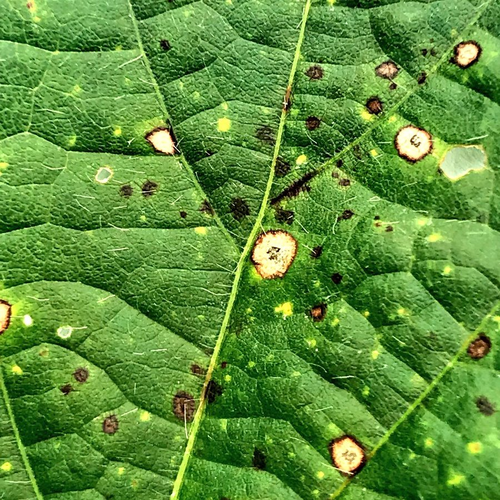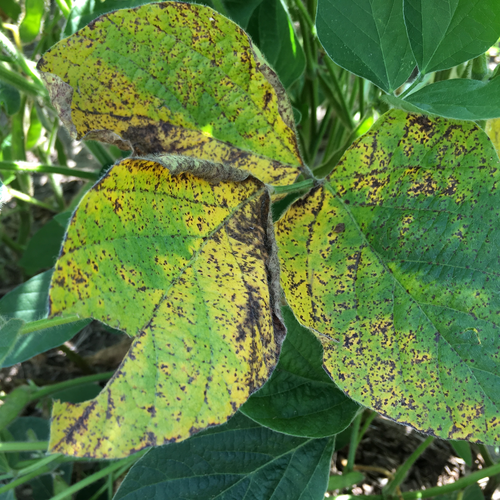Continuing our 2-part series on soybean diseases, each of these diseases shows signs after flowering and could infect your soybean crop, severely diminishing yield potential. However, with proper identification and control strategies, yield damage can be minimized.
For additional idenitifaction tips, read the first part of our series -
Soybean Root Disease Identification.Frogeye Leaf Spot- Keys to identification: Symptoms are seen primarily on leaves as lesions. Lesions consist of small, circular to irregular dark spots which develop on the upper leaf surfaces. Eventually, the spots enlarge and inhibit photosynthesis, and the centers of the lesions become gray to brown with red or purple margins. Heavily spotted leaves usually wither and drop off prematurely.
- When to Watch: Frogeye leaf spot is most serious in warm regions or during humid, wet weather. Leaves developing during warm, wet conditions are more likely to be infected than leaves expanding during dry periods. Infection can occur at any stage of soybean development but mostly occurs during flowering.
 Septoria Leaf Spot (Brown Spot)
Septoria Leaf Spot (Brown Spot) - Keys to identification: Brown spot causes small, angular or circular brown and red spots on unifoliate and lower trifoliate leaves. Infected unifoliate leaves will yellow and drop prematurely. The disease usually appears on the lower section of the plant, but under warm, wet conditions, the disease may travel up through the plant.
- When to Watch: Although infection can occur at any stage of soybean development, brown spot often appears after flowering.
 Anthracnose
Anthracnose - Keys to identification: Typically, this fungal disease develops as a stem and pod disease during later reproductive growth. Anthracnose may also cause tip blight in early pod-filling stages. The fungus produces acervuli, small black fruiting bodies that erupt in infected tissue. Irregularly-shaped brown lesions also may develop on pods, petioles and stems.
- When to Watch: Anthracnose typically develops in warm, wet weather. If wet weather continues through harvest, the symptoms on stems will be more severe.
 Sudden Death Syndrome (SDS)
Sudden Death Syndrome (SDS) - Keys to identification: Soybean Sudden Death Syndrome (SDS) causes interveinal chlorotic or necrotic spots and may cause leaves to curl up or drop prematurely while the petioles remain firmly attached. Fields with severe foliar symptoms will have a tan to brown cast. Later, flowers abort and pods fail to fill seed. One characteristic of SDS is that the interior or pith of the stem remains white. SDS can occur as a disease complex with soybean cyst nematode (SCN), often resulting in early and more severe symptoms.
- When to Watch: The above ground symptoms of SDS generally appear midsummer after blooming, but the infection of the pathogen (Fusarium virguliforme) occurs at the seedling stage. This disease is a serious threat from the time the seed starts to germinate and throughout the growing season. Since SDS attacks at the root first, by the time above-ground symptoms are visible, it's too late to protect against the disease.
 Pod and Stem Blight
Pod and Stem Blight- Keys to identification: Key signs of blight include many small black raised dots arranged in rows on infected stems, pods or fallen petioles. Upper portions of infected plants may turn yellow and die. Infected seeds are cracked, shriveled and dull and may have a gray mold. Infected seeds also can have low viability and decompose at harvest.
- When to Watch: This disease is more common when harvesting is delayed during wet weather. Signs of infection can also appear in mid-season, late-season and as plants near maturity.
 Comprehensive Control Strategies
Comprehensive Control Strategies Protect the yield potential of your high-yielding soybean crop with a multiple mode of action fungicide such as
Trivapro®,
Miravis® Neo or
Miravis® Top. Always read and follow fungicide labels to identify the best fungicide for addressing diseases observed in your fields.
As you plan ahead to next season, you can reduce the risk of potential outbreaks by treating your soybean seed with a Golden Harvest
® seed treatment. This will ensure that your seedlings have a fast and healthy emergence and will be better protected throughout the season. Incorporating these disease control strategies in your production plan will allow your soybean crop to achieve its highest yield potential. Contact your
Golden Harvest Seed Advisor about Golden Harvest soybean varieties, seed treatment options and additional agronomic insight.
Photos are either the property of Syngenta or used under agreement.
Syngenta hereby disclaims liability for third-party websites.